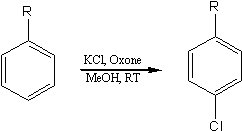Para-Chlorination of Aromatics using KCl/Oxone[ Back to the Chemistry Archive ]In this communication we report a new method for the para selective (regioselective) oxychlorination of aromatic compounds using commercially available Oxone® as an oxidant and KCl as a chlorine source. We observed smooth chlorinations in acetonitrile without any additional catalyst. 
A number of different aromatic substrates were subjected to the chlorination reaction to test the generality of this method and the results are summarized in Table 1. These reactions proceeded efficiently under mild conditions in acetonitrile with high yields and regioselectivity with KCl and Oxone®. Potassium peroxymonosulfate is an inexpensive and readily accessible oxidizing agent. It is commonly used as Oxone® (2KHSO5·KHSO4·K2SO4) and is a versatile oxidant for the transformation of a wide range of functional groups. Introduction of an electron-withdrawing group on the aromatic ring substantially decreases the rate of ring chlorination (Table 1, Entries 7 and 10) while on electron donating group increases it. As is evident from the Table 1 aromatic substrates of greater, moderate reactivity ex. methoxy, hydroxy and alkyl benzenes react readily with KCl/Oxone® to give essentially quantitative yields of the monochloro derivatives with high para selectivity with little or no tendency to polychlorination. Less reactive substrates such as nitrobenzene, chlorobenzene, benzoic acid could not be chlorinated even at elevated temperature (80°C). In the case of 2-nitrophenol the corresponding monochloro phenol (4- chloro-2-nitrophenol) was obtained in moderate yields. The results show that chlorination of toluene (Table 2, Entry 4) with two fold excess of KCl and Oxone® afforded (mono) 2 and 4-chlorotoluene in 97% yield and a small amount (3%) of 2,4-dichlorotoluene, whereas anisole, phenol and acetanilide (Table 2, Entries 1–3) furnished dichlorinated compounds as a major products along with a small amount of monochlorinated compounds. The interesting difference between highly activated aromatics gives the dichlorinated compounds whereas moderately activated aromatics gives the monochlorinated compounds. Then, we can selectively prepare the desired chloro-substituted compound by using calculated amount of KCl and Oxone® in case of highly activated aromatics. A wide range of solvents has been employed in these reactions (Table 3), including carbon tetrachloride, hexane, dichloromethane, methanol and acetonitrile. However, the yields, rates of reaction and degree of paraselectivity generally appeared to be optimum in acetonitrile. Two experimental parameters deserve emphasis. First, the nature of the solvent has a dramatic influence on the regioselectivity. Switching from the non-polar carbon tetrachloride (polarity = 0.0D) to the strongly polar acetonitrile (polarity = 3.92D) results in a change of yields from 0 to 98% for anisole chlorination. Even greater paraselectivity (para/ortho upto 90/8) was obtained by using acetonitrile as a solvent compared to methanol. Secondly, the nature of oxidant used has a dramatic influence on the yields and selectivity. We surveyed the oxychlorination with various oxidants. Reactions were conducted with anisole as a probe-substrate at room temperature in acetonitrile. However, Oxone® is far superior to the other oxidants for example, H2O2 give little of the product and TBHP and molecular O2 showed no sign of reaction after 15 h. The best oxidant is Oxone® from the standpoint of highest yield and selectivity. The reaction proceeds efficiently in high yields at ambient temperature and pressure. In conclusion, we have developed a novel system for the regioselective oxychlorination of aromatic compounds by using KCl and Oxone® in acetonitrile under ambient conditions. The results reported here demonstrate that reagent system possess considerable practical advantages over traditional reagents for electrophilic chlorination reactions. The commercial availability of the reagents and reactions are clean, high yielding and work-up is simple. The absence of side chain chlorination products in reaction conducted in acetonitrile suggests a substantial increase in the rate of the ionic process. We are currently extending this methodology to other halogenation reactions. General Procedure for the Chlorination of Aromatic Compounds:Oxone® (2.2 mmol) was added to a well stirred solution of KCl (2.2 mmol) and substrate (2 mmol) in acetonitrile (10 ml) and the reaction mixture was allowed to stir at room temperature. The reaction was monitered by thin layer chromatography (TLC). After the completion of the reaction, the mixture was filtered and solvent evaporated under reduced pressure. The products were purified by column chromatography over silica gel and confirmed by 1H NMR and Mass spectra. References[1] Synth.Commun. 31(13), 2021-2028 (2001) |